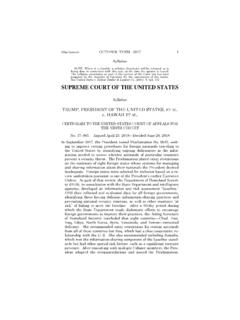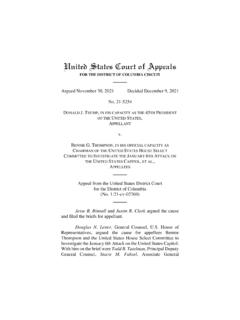Transcription of A Legal Analysis of Genocide
1 A Legal Analysis of Genocide S U P P L E M E N T A R Y R E P O R Tof theNATIONAL INQUIRY INTO MISSING AND MURDERED INDIGENOUS WOMEN AND GIRLS This supplementary Legal Analysis represents the views and opinions of the National Inquiry. In reaching our conclusion, we consulted with international Legal scholars and lawyers with expertise on Genocide and international crimes. The National Inquiry would like to thank, in particular, the contributions and insights of Professor Fannie Lafontaine, holder of the Canada Research Chair on International Criminal Justice and Human Rights at Universit Laval; Amanda Ghahremani,international criminal lawyer and former Legal Director of the Canadian Centre for International Justice.
2 And Catherine Savard, candidate at Universit are respectively Director, Investigator and Assistant-Coordinator of the Canadian Partnership for International publication est galement disponible en fran ais :Une analyse juridique du g nocide: un rapport suppl mentaire de l'Enqu te nationale surles femmes et les filles autochtones disparues et assassin esCOVER IMAGE:Special thanks to the artists whose work appears on the cover of this report:Dee-Jay Monika Rumbolt (Snowbird), for Motherly LoveThe Saa-Ust Centre, for the star blanket community art pieceChristi Belcourt, for This Painting is a Mirror TABLE OF CONTENTSi Section 1: INTRODUCTIONS ection 2: DEFINING GENOCIDEa) Genocide in International Law.
3 Definition, Sources and Responsibilityb) History of the Genocide Convention and Exclusion of Indigenous Perspectivesc) Genocide and the Traditional Exclusion of Gender Perspectivesd) The Particular Nature of Colonial GenocideSection 3: CANADA S ACTIONS AND OMISSIONS AS GENOCIDAL AND OBLIGATIONS FOR REPARATIONSB ibliography 1312 CONDUCT (ACTUS REUS)a) Protected Groupsb) Genocidal Conduct the Five Prohibited Acts/Omissionsi. Applicable Law for Genocide by Killingii. Applicable Law for Genocide by Serious Bodily or Mental Harmiii. Applicable Law for Genocide by Inflicting Conditions of Life Meant to Bring aboutPhysical Destructioniv.
4 Applicable Law for Genocide by Imposing Measures Intended to Prevent Births withinthe Groupv. Applicable Law for Genocide by Forced Transfer of Children from One Group toAnotherc) Canada s Policies as Elements of the Actus ReusSection 4: CANADA S SPECIFIC INTENT TO DESTROY INDIGENOUS PEOPLES (MENS REA) 19a) What is Specific Intent for a State?b) What does intent to destroy a protected group mean?c) Canada s intent to destroy Indigenous PeoplesSection 5: CONCLUSION: CANADA S RESPONSIBILITY FOR GENOCIDE2634 1 1. INTRODUCTION The mandate of the National Inquiry into Missing and Murdered Indigenous Women and Girls is, broadly speaking, to assess the root causes of the violence against Indigenous women and girls. The National Inquiry has determined that colonial structures and policies are persistent in Canada and constitute a root cause of the violence experienced by Indigenous women, girls, and 2 SLGBTQQIA people.
5 The report highlights that the thousands of truths shared before the National Inquiry reinforce the existence of acts of Genocide against Indigenous women, girls, and 2 SLGBTQQIA people: The violence the National Inquiry heard about amounts to a race-based Genocide of Indigenous Peoples, including First Nations, Inuit and M tis, which especially targets women, girls, and 2 SLGBTQQIA people. This Genocide has been empowered by colonial structures, evidenced notably by the Indian Act, the Sixties Scoop, residential schools and breaches of human and Indigenous rights, leading directly to the current increased rates of violence, death, and suicide in Indigenous This supplementary report offers Legal Analysis and discussion supporting this conclusion. The National Inquiry acknowledges that the determination of formal liability for the commission of Genocide is to be made before judicial bodies. An assessment of both individual and state responsibility requires a considerable body of evidence and must be carried out by a competent tribunal charged with this task.
6 The National Inquiry does not intend to fully demonstrate all the elements of a genocidal policy, since it does not have direct access to all of the evidence related to it. However, the information and testimonies collected by the National Inquiry provide serious reasons to believe that Canada s past and current policies, omissions, and actions towards First Nations Peoples, Inuit and M tis amount to Genocide , in breach of Canada s international obligations, triggering its responsibility under international law. This report is limited to a Legal Analysis of Genocide , but the National Inquiry s findings call for a broader examination of other international crimes, including in particular, crimes against humanity. In Section 2, we discuss the definition of Genocide . We outline the sources of the prohibition of Genocide in international law, as well as the scope of the responsibility for breaching this rule, distinguishing state responsibility and individual responsibility.
7 We provide a brief history of the drafting of this definition in treaty law and its failure to incorporate Indigenous and gender perspectives, and explain the unique nature of colonial Genocide , which is unlike the traditional understanding of Genocide derived from the Holocaust prototype . 2 In Section 3, we examine the material elements (actus reus) of Genocide . We present the Legal criteria to determine the existence of a protected group (national, ethnic, racial or religious) and of the five prohibited genocidal types of conduct. We then turn to assess whether Canada s past and current policies, actions and omissions in relation to Indigenous Peoples qualify as genocidal Section 4, we examine the definition and nature of genocidal intent , and how the specific intent to destroy element may apply to state conduct rather than individual behaviour. We assess the meaning of destruction within the Legal definition of Genocide and we scrutinize the existence of such a specific intent in Section 5, we explain the consequences of Canada s breach of international law and elucidate Canada s obligations to provide reparations and redress to Indigenous Peoples, particularly women, girls, and 2 SLGTQQIA people.
8 3 2. DEFINING Genocide a) Genocide in International Law: Definition, Sources and Responsibility The prohibition of Genocide is contained both in international treaties and in customary international law and gives rise to both individual criminal responsibility and state responsibility. Genocide is defined in the Genocide Convention as: [..] any of the following acts committed with intent to destroy, in whole or in part, a national, ethnical, racial or religious group, as such: (a) Killing members of the group; (b) Causing serious bodily or mental harm to members of the group; (c) Deliberately inflicting on the group conditions of life calculated to bring about its physical destruction in whole or in part; (d) Imposing measures intended to prevent births within the group; (e) Forcibly transferring children of the group to another Statutes of international criminal tribunals have replicated the same The prohibition of Genocide , a modern word for an old crime, 4 does not merely constitute a conventional norm (provided by treaty).
9 It has consistently been qualified as a universal and peremptory norm of customary international law: The prohibition of Genocide [..] has generally been accepted as having the status not of an ordinary rule of international law but of jus cogens. Indeed, the prohibition of Genocide has long been regarded as one of the few undoubted examples of jus cogens. 5 International criminal tribunals have acknowledged the multiplicity of sources for the prohibition of Genocide , both as a conventional norm and as customary international law: [..] although the [ Genocide ] Convention was adopted during the same period that the term Genocide itself was coined, the Convention has been viewed as codifying a norm of international law long recognised and which case-law would soon elevate to the level of a peremptory norm of general international law (jus cogens).6 The commentary to Article 26 on the Responsibility of States for Internationally Wrongful Acts expressly mentions that Genocide is one of the peremptory norms that are clearly accepted and recognized.
10 7 4 In the Canadian Crimes Against Humanity and War Crimes Act, Genocide is defined as: [..] an act or omission committed with intent to destroy, in whole or in part, an identifiable group of persons, as such, that, at the time and in the place of its commission, constitutes Genocide according to customary international law or conventional international law or by virtue of its being criminal according to the general principles of law recognized by the community of nations, whether or not it constitutes a contravention of the law in force at the time and in the place of its commission. 8 The Canadian definition relies partly on the international definition found in the Genocide Convention and the Rome Statute of the International Criminal Court; two international treaties to which Canada is a party. However, the domestic statute explicitly adds one important element to the definition of Genocide : omissions that is, the failure to act can constitute genocidal conduct.






